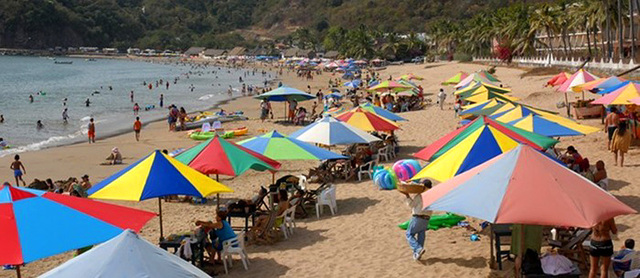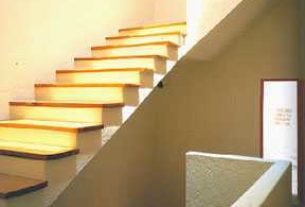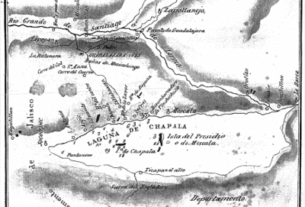
Five years ago, I visited the Mexican sea-side resort of San Patricio (Melaque), Jalisco. I arrived with my family and small trailer to join an amiable colony of recreation vehicle campers at the free beach located at the far north end. My impression of Melaque could be summarized in one word… mellow. Graphic rocky hills framed a sweeping three mile expanse of sandy beach. The turquoise waters of the bay were sparkling, warm and clean. The surf thundered steadily against the shore, powerful enough for an invigorating swim but not strong enough for danger.
During that initial visit, this large informal camp-ground which nestled against the rocky bluffs, was in some sort of municipal dispute over the freedom to camp there. It was still free camping and many rigs were settled in for the customary six months. A herd of speckled goats wandered at will through the campground to munch at the daily compost. A woman named Rosa lived in a simple palapa dwelling on the lovely beach, with her several children by various fathers. My children would play ball every day with hers and swim in Melaque’s benevolent warm waters. Life assumed a languid, tropical village pace.
Daily activities centered around the camp-ground, the beach, and frequent visits to the main village located one mile away. I dimly remember Rosa’s attempts to draw me into settling a dispute (in her favor!) over a rooster, before I snapped to and realized that San Patricio poultry disputes were none of my business.
A big, pink pig snorted and rolled in the dust where he was tied to a papaya tree in the shade. Rosa was fattening him with the assistance of the resident campers who contributed to his meager diet. As a long-time raiser and fan of pigs in general, I grew rather fond of his snuffling presence on my daily walks up the rocky bluffs to catch the stunning view of the bay.
From the top of the cliffs, for as far as the eye could see, Melaque and its surrounding tropical plantations stretched out into the horizon. Day hikes through the scrubby cliff underbrush led to the discovery of tiny, quiet rocky bays. Here picnics and beach-combing for shells, rocks, sponges, bones and other assorted “treasure” absorbed the exploratory hours.
During that first visit here, I had grown to appreciate this peaceful sea-side Mexican village. Melaque escaped the busyness and omnipotent tourist presence of its sister village of Barra de Navidad. Its main hotel was the sprawling Hotel Casa Grande which we had dubbed the “pink prison” as its bid for commercial dollars out-distanced its aesthetic appeal. As many of Mexico’s less developed western beaches are frequented by unpredictable rip tides, I enjoyed the fact that I could relax by the ocean and open just one eye at a time to monitor my three children frolicking in the non-threatening waves.
In the intervening five years, we had heard on the news that Melaque had received considerable earthquake damage in l994. I wondered how it had affected the people and what would have changed.
My chance to return came in February, 1998. This time, I flew directly from Vancouver to Manzanillo for two weeks with two of my children, now aged 12 and 14. Even minus Dad, big brother and protective trailer, we were all nevertheless more than ready to be there. After a four hour direct flight, our taxi driver drove us from the Playa de Oro airport at break-neck speed through the black, starry Mexican night towards Melaque. At two a.m., the village looked familiar and unchanged. As a bevy of crowing roosters greeted our first day a few hours later, I ventured out onto the streets.
Rosa, the goats and the pig are now gone from the decidedly tidier camp-ground. And no-one returned my smile or good morning waves as I toured the site. Perhaps this was a change in my status from neighbor to visitor.
Everywhere, people prepared for their day’s business. Evidence still remained of earthquake damage. Hotel Casa Grande was a ruin of its former self although most of it was still standing. Its deserted presence had affected many of the surrounding thatched palapa style restaurants. Generally empty through the week, one of them did erupt with a lively dance on Saturday night. Over 100 senior gringos were dancing the night away! Many small hotel owners had suffered financially but I listened to stories of how individuals (including long term American patrons) had loaned business people money to repair earthquake damage when it was nearly impossible to get bank loans.
My hotel manager said that only this year had tourism recovered. Tourism is considered by many to be the economic life-blood of the village even though the region abounds with large, lush tropical plantations of coconuts, papayas and bananas. The village atmosphere seemed one of general prosperity as I discovered during my daily hour long morning walks. As I walked every street, contrast greeted me at every moment. Some areas were gorgeous with neat homes surrounded by lush vegetation while the property next door, resembled a garbage dump. Laguna Tule greeted me at the far south end of the village. Fishermen poled their pangas through sheltered lagoon waters amidst flocks of water fowl and other birds.
Tranqualilidad. Tranquility
On our second day, which was Sunday, the tourist grape-vine suggested that the town plaza was “happening” that evening. We sallied forth to join in the traditional Sunday evening promenade or “paseo dominical”. My teens were intrigued by this custom of young men and women walking informally in separate groups around the village plaza. To see and be seen: now this was something that they could relate to! As we continued to walk around and around the plaza, more and more families and tourists arrived to sit on low concrete walls or join the walk-about. Music blaring from a sound system rivaled a five piece live band on the street corner. Street vendors prepared delicious finger food whose odors drifted in the night air. The quiet dusty village streets continued to spew forth more of their inhabitants in this grand social gesture. They provided the social ambiance, the audience for which the oldest show on earth was being subtly re-enacted.
The show is called “Boy meets Girl. ” Girls in small groups of amigas (girlfriends), walked and talked together, acting as if the circling boys were of no real importance to them. However, everything about their dress, hair and make-up suggested the contrary.
Dresses hugged their youthful female figures in many eye-popping styles. The hair was braided, coifed, bedecked and bejeweled with bows and barettes. The facial make-up applied with fashion and flare. The boys, for their part, could scarcely fail to notice the beauty on parade before them. Once in awhile, little conversations would ignite between revolving parties on the continuous promenade. Flirtatious remarks, or ” piropos” exchanged directly or indirectly. It was a public dating game and a refreshingly different custom for us to witness. It lasted for the entire evening!
In the early evening, the village church opposite the plaza was bursting with the faithful. After the service, families wandered over to join the Sunday evening social.
The needs of children for active fun was met by two large trampolines surrounded by fishing net for safety. A gringo tooting on a kazoo, and manipulating a group of walking marionette ducklings ambled past with a trail of following children. The Pied Piper of San Patricio! Small neat-appearing boys raced little cars and trucks around the unoccupied parts of the wall.
I noticed that there were large flat cardboard trays of eggs stacked upon some vendor’s tables. It made scant sense that people would be buying eggs in this festive atmosphere at night. Petite girls in pretty dresses and frilly socks suddenly dashed these eggs upon the cement walkway. Clouds of powdery flour wafted in the air as the girls giggled at their own daring. These eggs had been emptied of their contents, dried, filled with a powdery flour (some have confetti), and then sealed with tissue paper and tape or glue. They are always found at a carnival or fiesta, and they always bring delight to the children as they cavort amongst the spumes of flour..
I breathed a silent thank-you to again be enjoying myself in Mexico.



A beautiful story which describes San Patricio’s live so perfect. Thank you for sharing and saying it the way you did, I have been in Melaque year after year for the past 20 years, is by far the best town for me and my family. I am Mexican (From Jalisco State) but live in California for 32 years, they way you wrote your story about San Patricio really makes me feel I was there.
One day when I retire, I am thinking to move and live there or at least come and spend chunks of time each year because I felt in love of San Patricio and it’s people.